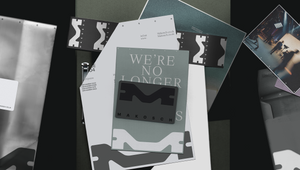
How the Woolwork Company Drenched People in Oil to Show the Impact of Synthetic Clothing

“Wear Wool, Not Fossil Fuel”
This is what the newest campaign produced by 20something, Park Village and Studio Birthplace for The Woolmark Company urges its customers to do, by educating them about the hidden impact of synthetic fabrics on the environment.
The insight at the heart of the campaign found that every 25 minutes, an Olympic pool’s worth of crude oil is used to produce the synthetic clothing we wear, which amounts to around 350 million barrels of oil a year. The 60-second hero film as the face of the campaign pictured a powerful visual message, highlighting the ways in which customers cannot escape the purchase and usage of synthetic materials and what that really means for us and the environment.
The film shows three people swimming in an Olympic pool full of crude oil, struggling to make their way out. Once they do, we see the message “It’s time to change” as the actors strip the oil-drenched clothes to reveal outfits made of natural 100% biodegradable and renewable Merino wool. The film was also accompanied by visually immersive DOOH in iconic sites in London’s Piccadilly Circus and New York’s Times Square. The billboards came in pairs with one stating “Wear wool” and the other finishing the statement with “Not Fossil Fuel”, which brought home the images of a person dressed in natural fabrics, and one drenched in oil.
Talking about the brief for the project, 20something’s business director Anisha Obeng explains that it was collaborative from the get-go. Following their award-winning work on Wasteminster for Greenpeace, The Woolmark Company approached Studio Birthplace to work on this project who, through their representatives Park Village, then got in contact with 20something.
As one can imagine, a huge amount of research goes into campaigns regarding sustainable practices and this one doesn’t fall short. “There was a huge amount of qualitative research on the production of synthetic clothing,” says Anisha. “We aimed to find a fact that would resonate with the audience and make the intangible, tangible. While most people knew that synthetic clothing wasn’t sustainable, few of them are aware of the extent of the problem or the plastic that goes into creating these clothes. Through our calculations based on research from the Ellen MacArthur Foundation we worked out that the Olympic-sized pool, something most people have seen, was used every 25 minutes.” This proved to be the perfect insight that would bring the project to life.
A lot of customers are now becoming aware of the negative effects fast fashion has on the planet, however still a large portion of them don’t have the means to carry a sustainable lifestyle, as a lot of natural fabrics are more expensive to obtain. This remains fact, but Anisha explains that although synthetic clothing is the cheaper option, “what most people don’t consider at the point of purchase is the fact that the lifespan of these clothes is much less. While you might spend less in the shops, over time the cost will rack up. We want to change the attitude of consumers from fast fashion, from buying what’s there now for the best price, to future-facing – something that will stand the test of time. It’s about buying less but buying better. Wool also needs less washing and can be washed at lower temperatures. Not to mention that it’s biodegradable and won’t affect the planet by shedding microplastics like synthetic fibres do. By including the material in their purchase journey, shoppers are investing in their wardrobe and the future of the planet.”
Laura Armstrong, general manager, marketing communications at The Woolmark Company agrees. She explains that much of the brand’s marketing in general is concentrated on educating citizens to “buy less, but better”. “Our research showed that the connection between fibre and clothing, and synthetics and fossil fuel was not being made. We want to change this through fibre fact and impact education.”
Anisha also explains that during the planning phase, the team at 20something reached the conclusion that OOH is a brilliant channel for achieving impactful reach across key shopping and fashion hotspots, particularly during Fashion Week and the whole month of September, which is crucial for the fashion community. “We have a striking visual and the dichotomy device allows us to reflect both the problem of synthetics and the benefit of a natural fibre such as wool,” added Anisha.

When looking at the film itself one can’t help but ask how the visuals were achieved. Did people actually swim in crude oil? The special effects team MXFX actually built a custom six by six-metre pool that got filled with 36,000 litres of bio-based fake oil, created from a mixture of water, food thickener and edible children’s paint. “Harmless on skin and planet, but very sticky and cold, which became a challenge for the actors who swam in it to deal with,” jokes Adam Booth, managing partner and EP at Park Village. In terms of filming, Adam says that it started with the rural landscapes and the backplates. “This way we knew precisely how the lighting and backgrounds would look. We then filmed the remaining live action in a purpose-built oil tank in a studio. The imagery you see of people swimming and emerging from the oil are entirely in camera, practical effects. The expanse of the pool in the landscape was VFX built from still images and CGI, and the moment of clothing transition was painstaking CHI and plates of the cast, captured clean and then captured covered in the oil.”
The light reflections on set were also a complicated process created through pre-visualization made by Dead Pixel, the visual effects team for the project in Amsterdam. “Lighting the pool was a significant challenge as the black liquid filled pool essentially acted as a big mirror, reflecting everything visible in the studio,” explains Adam. “Based on 2D testing and research, we decided to build a white dome over the pool that we then lit to match the nature plates that were previously shot on location.” After that, the pool was visually extended to the size of an Olympic one, enhancing the environments that were shot and creating digital doubles of the talent to interact with the digital oil simulations. Ultimately, the VFX and oil itself took months of testing. “We’d already submerged the cast multiple times before we got to the shoot and created numerous different mixes of the oil to achieve the correct viscosity.”
From a brand perspective, The Woolmark Company had a very clear purpose from the start. Knowing that not many industries have the benefit of having direct and meaningful conversations with the entire supply chain, the brand decided that they can advise the woolgrowers what the fashion c-suite wants and “in turn communicate the goals and frameworks of wool-growing producers,” explains Laura.
To The Woolmark Company, collaboration is crucial especially on their sustainability journey and they recognise it is one that is constantly evolving. “Our sustainability pillars provide a framework to help enable all stages of the wool supply chain achieve their ethical goals and help our industry deliver positive outcomes for people, planet and prosperity.” And although sustainability has been a topic of discussion for too long, lately it has been truly accelerated by the Covid pandemic. “It has come to the fore,” says Laura. “Some brands are transitioning faster than others. But it has always been at the core of what we do - engaging with woolgrowers to find better land management solutions, engaging with the supply chain to innovate cleaner processes and engaging with brands, retailers and consumers such as via our latest campaign. We see so many 2030 goals being made but we see these being pivoted as many goals are being reached before 2030. So 10 years from now? That’s hard to answer. But a few years from now - we will see greater traceability, greater transparency and hopefully a greater recognition of fibre choice and material impact.”















